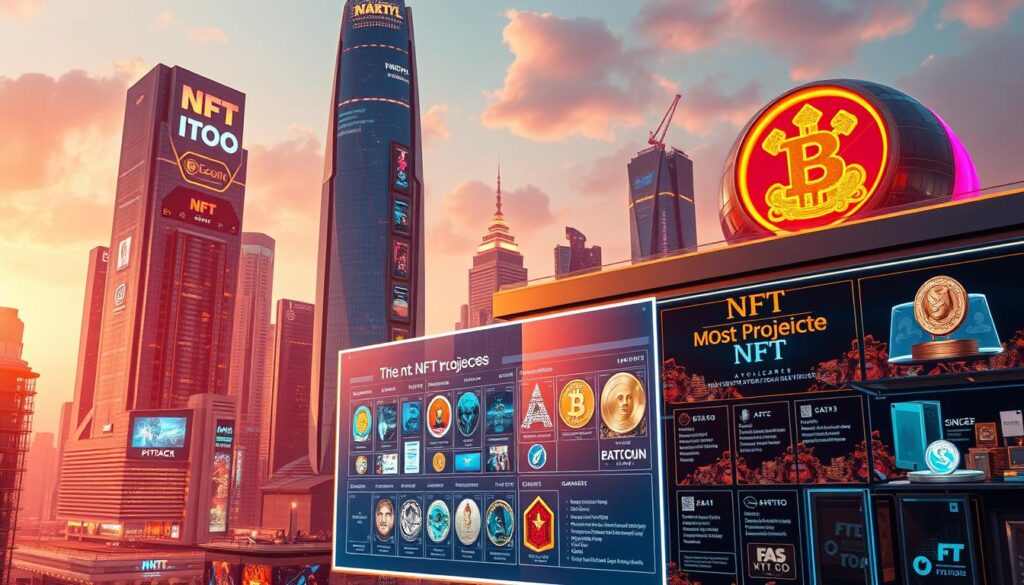Now Reading: Navigating NFT Intellectual Property: What You Need to Know
- 01
Navigating NFT Intellectual Property: What You Need to Know
Navigating NFT Intellectual Property: What You Need to Know
Digital collectibles exploded into mainstream culture in 2017, transforming how we think about ownership in the internet age. Projects like CryptoKitties showed the world how blockchain could make unique digital items tradable. Today, multi-million dollar sales – from digital art to viral tweets – prove this technology isn’t just a passing trend.

These blockchain tokens create new opportunities and challenges. While they verify authenticity through unique codes, owning one doesn’t always mean controlling the original work. Many buyers discover too late that their purchase grants limited permissions unless specifically stated in smart contracts.
The legal landscape struggles to keep up with rapid tech advances. Traditional ideas about creative ownership clash with decentralized systems where transactions happen globally in seconds. Artists, collectors, and businesses all face unanswered questions about licensing and commercial use.
Key Takeaways
- Digital collectibles gained traction in 2017 but built on blockchain concepts developed years earlier
- Ownership of a token doesn’t automatically include control over linked content
- Smart contracts define what buyers can do with purchased items
- Major sales highlight both potential and legal gray areas
- Creators must clearly outline permissions during minting
- Existing copyright laws apply differently to blockchain-based assets
This guide breaks down the essential facts about blockchain-based ownership. You’ll learn how to protect your interests whether you’re creating, buying, or selling digital assets in this evolving space.
The Evolution of NFTs and Intellectual Property
The story of unique digital assets began quietly in 2012, when early blockchain experiments tested ways to verify ownership of virtual items. These prototypes laid the groundwork for what would later become a cultural revolution. By 2017, a playful project called CryptoKitties turned theoretical concepts into mainstream reality, letting users breed and trade one-of-a-kind cartoon felines.

From Obscure Tech to Global Phenomenon
CryptoKitties became more than a game – it proved blockchain could handle unique digital items at scale. This breakthrough opened floodgates for creative applications. Artists soon realized they could attach their work to non-fungible tokens, creating verifiable scarcity in the infinite digital realm.
When Digital Items Made History
The market exploded with jaw-dropping milestones:
- Beeple’s $69M collage sale through Christie’s (2021)
- Jack Dorsey’s first tweet fetching $2.9M (2021)
- NBA Top Shot surpassing $500M in sales (2021)
These transactions forced traditional institutions to acknowledge digital art’s value. However, they also exposed gaps in understanding what buyers truly own. A $300,000 virtual cat image might seem absurd, but it represents a fundamental shift in how we assign worth to digital creations.
As prices soared, creators and collectors alike grappled with new questions. Can you own a tweet? What happens when blockchain entries outlast the content they reference? The answers remain unclear, but the technology’s impact on creative industries is undeniable.
Fundamentals of NFT IP rights
Legal frameworks governing creative works face unprecedented challenges in blockchain environments. While digital tokens verify authenticity, they don’t inherently transfer control over linked content. This distinction lies at the heart of modern ownership debates.

Copyright and trademark protections follow centuries-old principles, even for virtual assets. Creators retain control over reproduction, distribution, and adaptation unless explicitly granted through agreements. A digital token acts like a signed baseball – owning the item doesn’t let you mass-produce replicas.
Three critical concepts define these relationships:
- Creative works exist separately from their storage formats
- Blockchain entries serve as ownership certificates, not content licenses
- Smart contracts determine permissible uses beyond basic possession
Media often conflates token ownership with full creative control. In reality, purchasing digital art through blockchain platforms typically grants bragging rights, not commercial usage privileges. Artists can still pursue legal action if buyers exceed agreed terms.
Platforms and creators must clearly outline permissions during transactions. Ambiguous terms create risks for both parties – buyers might assume broader entitlements, while artists could lose revenue streams from derivative works. Proper documentation prevents costly disputes in this evolving legal frontier.
Decoding Blockchain, Smart Contracts, and Digital Ownership
At the core of digital ownership lies a trio of technologies working in concert. Distributed ledgers create tamper-proof records, while self-executing agreements automate transactions. Together, they form a new framework for verifying authenticity in the digital realm.

Understanding Smart Contract Mechanics
These automated agreements act as digital rulebooks. Built on platforms like Ethereum, they trigger actions when preset conditions meet. Common functions include:
- Executing instant sales when payment confirms
- Managing royalty splits during resales
- Restricting unauthorized content duplication
The code defines what buyers can – and can’t – do with acquired assets. Unlike paper contracts, these terms enforce themselves without human intervention.
The Role of Hashing and Metadata in Authenticity
Cryptographic fingerprints solve a critical challenge: proving uniqueness without storing massive files. Here’s how it works:
- Hashing algorithms convert digital files into unique string codes
- Metadata stores descriptive details like creation dates
- Combined, they create verifiable proof of originality
Most platforms store actual content off-chain due to blockchain storage limits. This separation means owning a token often means holding a verified reference to content, not the content itself. Global legal perspectives continue evolving around these technical realities.
While the technology enables new ownership models, users must understand its limitations. Servers hosting content can fail, and hashing doesn’t prevent screen captures. True digital ownership requires both technical understanding and clear legal frameworks.
How NFT Sales Impact Intellectual Property and Copyright
The digital art boom brought a critical question: what exactly do buyers own? A $2.9 million purchase of Jack Dorsey’s tweet revealed this dilemma. Buyers received a digital certificate, not control over the content itself.
Ownership of Digital Assets versus Underlying IP
Acquiring a blockchain token usually means getting bragging rights – not creative control. The Dorsey deal showed this clearly. Twitter kept all commercial usage permissions, preventing buyers from printing the tweet on merchandise.
Copyright law requires written agreements to transfer creative control. Automated sales through blockchain platforms don’t change this rule. Unless smart contracts explicitly state otherwise, artists retain legal power over their work.
Three factors create confusion in digital purchases:
- Metadata ownership ≠ content rights
- Automatic sales ≠ automatic permissions
- Token value ≠ creative control value
Platforms like Valuables use specific language to clarify these boundaries. Their sales agreements act as digital autographs, not licenses. This approach prevents legal headaches but surprises many collectors.
Clear terms protect everyone involved. Creators should outline permitted uses during minting. Buyers must check contract details before assuming they own more than a verified receipt.
Licensing, Royalties, and Monetizing Intellectual Property Through NFTs
Creative professionals now unlock revenue streams previously unimaginable in traditional markets. Blockchain technology enables precise control over how buyers interact with digital creations. This shift empowers artists while creating new business models for collectors.
Strategies for Licensing and Legal Assignments
Successful projects use smart contracts to define specific uses. CryptoKitties allows owners to monetize their digital pets up to $100,000 annually. NBA TopShots takes a different approach – buyers can display moments but can’t profit from merchandise or reproductions.
Three elements shape effective licensing:
- Scope: Clear boundaries for commercial vs personal use
- Duration: Time-limited or perpetual agreements
- Territory: Geographic restrictions when necessary
Platforms like OpenSea let creators attach terms directly to tokens. This transparency prevents disputes and builds trust in digital marketplaces.
Automatic Royalty Payments on Secondary Sales
Smart contracts revolutionize profit sharing. Artists receive 5-10% automatically when works resell. This system benefits gaming creators most – popular characters can generate income for years through countless trades.
Key advantages include:
- No manual tracking of resale transactions
- Instant payments via blockchain verification
- Customizable percentages per project
While traditional art markets lose creator revenue after initial sales, digital systems ensure ongoing compensation. Recent global licensing frameworks suggest these models could reshape entire industries.
Business applications extend beyond art. Musicians embed royalty splits in album tokens. Authors program royalties for ebook resales. The ability to automate financial relationships creates opportunities limited only by imagination – and clear legal agreements.
Battling Infringement: Copyright and Trademark Challenges in the NFT Ecosystem
Marketplaces face growing legal headaches as unauthorized token creation surges. Copying protected works violates two key permissions: reproduction (duplicating content) and communication (exposing it to unintended audiences). A musician’s leaked demo minted without consent, for example, could breach both protections simultaneously.
The Hermès v. Rothschild case set critical precedents. Artists creating “MetaBirkins” digital bags faced $133,000 penalties for using trademarked designs. Courts ruled this caused consumer confusion – buyers mistakenly linked the project to the luxury brand.
Disputes over Reproduction and Communication Rights
Defendants often claim fair use or artistic expression. Recent video game modding lawsuits show these arguments rarely succeed in commercial contexts. Blockchain’s anonymity complicates enforcement – tracking pseudonymous creators demands specialized tools.
Practical steps for protection:
- Register trademarks covering virtual goods
- Monitor blockchain transactions for unauthorized use
- Use takedown notices with platform operators
Brands must act swiftly. One fashion house halted $1.2M in counterfeit token sales by subpoenaing marketplace payment records. Clear documentation and proactive monitoring remain essential in this evolving space.
Legal Precedents and Key Court Cases in the NFT Landscape
Recent courtroom battles are defining the rules of digital ownership. Judges now grapple with complex questions about virtual property and creative control. Three landmark decisions reveal how courts interpret blockchain transactions under existing laws.
Influential Cases Shaping Regulation
The Dufoe v. DraftKings case established critical boundaries. Courts ruled buyers receive limited licenses for digital sports collectibles – not ownership of athlete names or images. This precedent impacts platforms offering branded digital rewards, requiring clear usage terms.
Insights From Trademark Disputes
Hermès’ victory against MetaBirkins creators set a powerful example. Courts awarded $133,000 for unauthorized use of trademarked designs, proving real-world brands have protection in virtual spaces. The decision warns creators against using recognizable elements without permission.
These cases show courts favoring traditional copyright and trademark laws over blockchain novelty. As one judge noted: “New technology doesn’t erase old rules.” Legal experts advise both parties to document permissions thoroughly before transactions.
FAQ
Does buying a digital collectible grant ownership of the original artwork?
Purchasing a tokenized asset typically grants ownership of the unique token, not the underlying creative work. The creator often retains copyright unless explicitly transferred through a smart contract or written agreement. For example, Beeple’s million sale included the token but not commercial rights to the art.
How do blockchain-based agreements ensure creators earn from resales?
Programmable features in decentralized ledgers can automate royalty payments each time an asset is resold. Platforms like Foundation or SuperRare embed these terms, ensuring artists receive a percentage (e.g., 10%) without manual tracking.
Can someone legally replicate an artist’s work as a tokenized item?
Unauthorized minting of protected content may violate reproduction rights. Courts have ruled against copycats, such as in the case where a developer cloned CryptoPunks. However, enforcement remains challenging across global platforms.
What legal risks arise when using branded content in tokenized projects?
Unlicensed use of logos or trademarks (e.g., Nike’s swoosh) can lead to litigation. The Hermès vs. MetaBirkins case set a precedent, emphasizing that trademark law applies even in virtual spaces. Clear licensing or transformative use is critical.
How does decentralized technology verify authenticity of digital items?
Cryptographic hashing creates a unique fingerprint for each item stored in metadata. Platforms like OpenSea use this to confirm provenance, ensuring buyers access verifiable records of an item’s origin and transaction history.
Are traditional licensing models compatible with blockchain-based assets?
Yes, but terms must adapt to decentralized frameworks. Creative Commons licenses, for instance, may conflict with resale mechanisms. Projects like Bored Ape Yacht Club use custom agreements, granting commercial rights to token holders while retaining some control.















